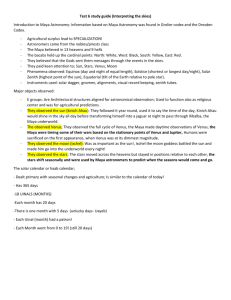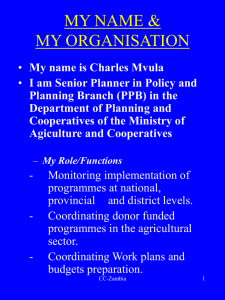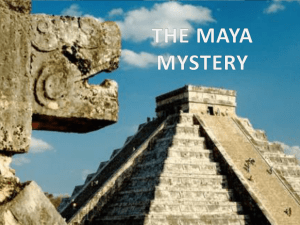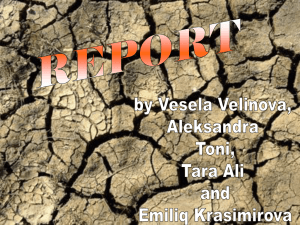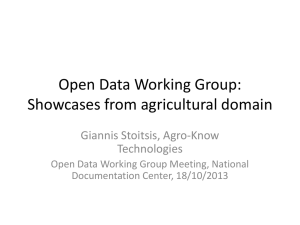Slide Show #10
advertisement
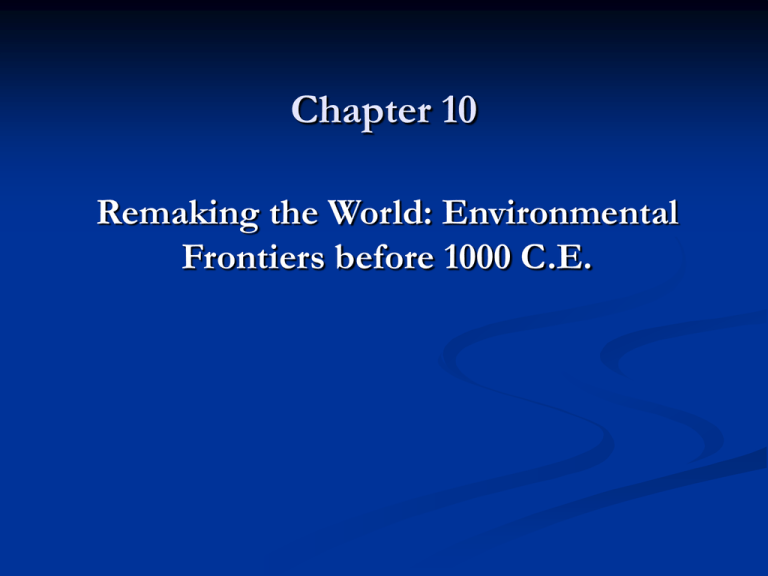
Chapter 10 Remaking the World: Environmental Frontiers before 1000 C.E. Review Questions HOW DID geography influence the transmission of culture in sub-Saharan Africa and the Americas? WHAT WERE the environmental consequences of the Islamic conquests in Africa and Eurasia? WHERE DID Christendom expand in the eighth and ninth centuries? HOW DID Japan, China, and the states of southeast Asia seek to stimulate economic growth? HOW DID Pacific islanders succeed in colonizing the Pacific? HOW WIDESPREAD during the history of this period was ecological experiment? Geography Affects Culture: Africa and America Difficulty of overcoming African geographical barriers: Sahara desert, coasts with few seaports, difficult rivers impede travel Large-scale migrations (Bantu) take longer than other continents Dense populations develop at western end of Sahel by 100 C.E. Senegambia region: mixed economy of farmers, ironworkers Ghana and Gao emerge as powerful states, 1000 C.E. Sacred kingship apparent in Ghana capital of Kambi-Saleh Trade and travel focus on reaching north of Sahara Ethiopia at eastern end of Sahel focused on Indian Ocean & Nile American isolation: sporadic contact w/Asia, Europe in pre-Columbus era N/S travel inhibited by mountain ranges, rivers Civilizations develop in Andes (S. America), Mesoamerica, N. American SW Dramatic shifts in climate/geography inhibit contact with other regions See Study Aid #10, Table 10.2 (Expanding States) for specific comparisons of regions Figure of a sacred king. The Oni, or king, of lle-lfe, excavated at lta Yemoo, Nigeria in 1957, 1000-1100 C.E. The king is shown draped in beads, a symbol of royalty. Nazca lines. The Nazca made the vast images for which they are famous by scraping the surface of the desert in Peru to reveal the bare rock underneath. But why did they do it? Vivid, intricate designs, such as this monkey, were too big to be fully visible except from the air. The people who made them can only have experienced them by walking the pathways the patterns made. The straight lines that accompany the images may have served as maps, perhaps indicating underground irrigation channels, but the pictures remain a mystery. Mayan kings. The legitimacy that royal ancestry conferred was an important part of Maya kingship— especially when things were going badly. Yax Pasaj, who became king of Copán in 763, when he was still a small boy, ruled in a time of economic decline and political unrest. This may be why he had himself depicted in the company of all Copán’s previous rulers, seated as if in conference around a small stone platform. Royal Bloodletting. The reign of Itzamnaaj B’alam (“Shield Jaguar”) II of Yaxchilián (681-742), in what is today Mexico, produced some of the finest stone reliefs in which Maya rulers commemorated their performance of important rituals. The most common ritual was royal bloodletting, which was intended to provoke visions. During these bloodlettings, kings communicated with ancestor’s or gods. The Dresden codex. The Maya almanac known as the Dresden Codex contains a wealth of data on agriculture, divination, and religion. But its most remarkable contents are the detailed astronomical observations and predictions,including the table recording the cycle of Venus, one page of which is shown here. The red bars and dots at bottom right are numbers, adding up to 584—the average number of days between the dates on which Venus rises with the sun. Such dates were favorable for war and sometimes foretold drought and death. The gods depicted represent from top to bottom, the Morning Star, Venus as bringer of war, and Venus demanding sacrifice. Environmental Effects of Islam in Africa, Asia Military expansion brings contact with new peoples, foods. Rice, citrus, cotton, dates, sugarcane From Mediterranean through Mideast, arid SW Asia, Sahel, savanna, tropical forests in Africa into India, SE Asia Systematic introduction of new crops sponsored by Islamic rulers Stimulates new forms of irrigation--underground tunnels, wells Increased clearance of forests, use of fertilizers Free markets encourage high productivity Expansion of markets 12,000 villages along Guadalquivir River in Spain (Cordoba) E/W trade: sea routes, land caravans Relative peace within empire increases quantity/value of trade Watermill. Increased agricultural output caused demand for more and bigger mills to grind grain. Most have not survived, but a fine example of medieval watermill technology, pictured here, is on the Orontes River at Hama, Syria. Water wheels on this scale also hoisted water from riverbeds to aqueducts and irrigation channels. Mayan Civilization Increased food production plus heightened trade in “cash” crops such as cacao increase population. Elites help support this through religious practices Bloodletting rituals “feed” gods, legitimate rulers Mass sacrifice of captive slaves, warriors Role of cacao throughout Mesoamerica Agricultural techniques spread north SW North America: Chaco canyon, Pueblo cultures Mississippian cultures: Cahokia, mound building in Southeast Ceremonial platforms built on terraced earthen pyramids Maya “collapse” may have in large part been a failure in agricultural production. Christendom Expands Military expansion into new areas in Central Europe Establishment of new Christian states in Slavic lands, Bulgaria Conversion strategies Co-opting pagan symbols, rituals, sacred sites Role of Charlemagne as French king, Holy Roman Emperor Role of Vikings, North sea region Establishment of new Christian states in Asturias and Barcelona in Spain Expansion into areas of pagan Britain China’s Economic, Political Growth Government encourages expansion through building of canal systems and more extensive irrigation. Price regulations, government granaries create stable supply Creation of Grand Canal, roads Efficient bureaucracy: taxation, justice officials travel widely Population expands, moves into uncultivated areas Southward shift into areas of rice cultivation Buddhist/Daoist monasteries help development in frontier regions Encouragement of small land holdings increases food production Tang Dynasty leaders break up large landholdings Major land reform of 737 divides estate lands among workers The Grand Canal. China’s ancient canals are still useful to commerce. Here, long lines of barges sail the Grand Canal, an artificial waterway that was first built in the seventh century C.E. The temple of Borobodur on the Indonesian island of Java began to receive pilgrims in the early 800s. Visitors, emerging from the dense tropical forest that surrounded the site, would ascend through four galleries, where stories of virtuous Buddhists were carved in relief eventually reaching the realm of Enlightenment— the circular platform, guarded by statues of Bodhisattvas. Japanese Expansion Governmental policies encourage population growth through adoption of new technologies in rice production and plowing. Early dynasties consolidate power by 700 C.E. Intensive management of limited agricultural land Encouragement to expand into and colonize frontier regions and to displace indigenous populations Expansion: northern Honshu to conquer native Emishi Southeast Asia Growth of Khmer kingdom (Cambodia) along with Viet, Cham regions Rich agricultural lands along Mekong river Ivory, wood, 3 crops of rice yearly New agricultural technologies increase food production. Populations rise and new states appear: Srivijaya, Sailendra. Srivijaya and Sailendra are also boosted by increased trade through the South Pacific islands. The Settlement of Polynesia Development of intensive agriculture on small islands in Micronesia Development of new technologies such as outrigger canoes Pohnpei and monumental religious architecture new navigation techniques Oral traditions to retain knowledge Spread of Polynesians across the Pacific Ocean First to Tahiti, then Marquesas, Hawaii final stop Common linguistic roots, religious concepts: Mana Today’s Question Do we have any place left to go? Consider The voyages of the Polynesians were amazing feats of exploration and settlement, opening up a whole new world for human communities. They also filled the last great hole in human habitation outside of Antarctica. Other new opportunities in the time of this chapter were also on ecological frontiers And the prospect of environmental catastrophe again is an issue What other environments offer possible destinations for human occupation? Is colonization of undersea environments, nearby planets, or even deep space a real possibility? What are the implications if all frontiers close?

